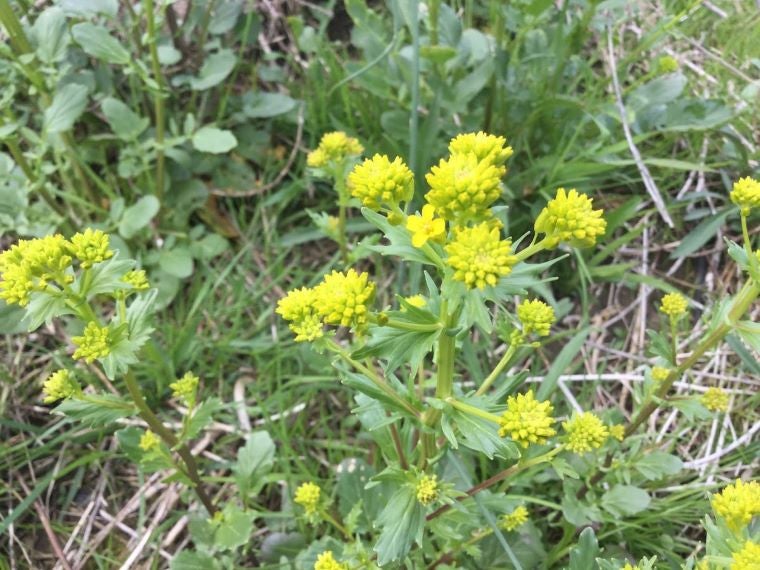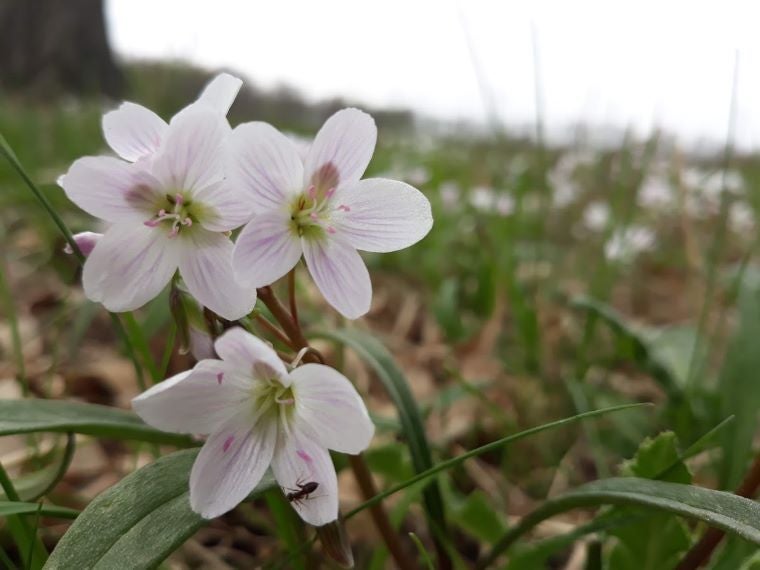There is beauty to be found in all seasons at Oberlin, but, in the spring, the campus shines. Melted slush and muddy paths give way to green grass, new leaves, and, best of all, flowers everywhere. Being away from Oberlin this spring, I miss seeing campus transform, but I know I will appreciate it all the more when I am back next year. In the meantime, this is my love letter to spring wildflowers on campus.
Bitter Wintercress (Barbarea vulgaris)

It seems fitting to me that this sunny plant grows amidst Oberlin’s solar array. It's a quiet spot, far to the north of campus, perfect for a long walk. Little rows of mulch create paths between the solar panels, but otherwise the grass in the field grows tall, dotted with wildflowers of all types.
This little yellow flower happens to be one of them. If you look closely, you can see it has four petals arranged in a cross shape. This is a telltale sign that it is a member of the mustard family. Other well-known members of this family include agricultural staples like kale, turnips, and broccoli. When I stumbled upon this plant, it was just beginning to bloom. I’m hoping next year I can visit the solar array a little later in the spring to see what it looks like in all its glory.
Downy Yellow Violet (Viola cf. pubescens)

I found this little bud while walking through the Oberlin Arboretum. The “arb,” as it’s affectionately called, is a small patch of woodland that marks the southernmost point on campus. Lots of classes visit the arb for everything from field work to artistic inspiration. On hot days, students pedal bikes there to swim in one of the arboretum’s ponds.
I have been to the arb many times, but last spring was the first time I saw a violet there. I immediately broke from the path to take a closer look. In the summer, my backyard at home is filled with white and purple violets, but this was the first yellow one I had ever seen. I felt like I had stumbled upon a mythical creature. I’m not completely sure of my identification here, as there are so many species of violet, but the hairs near the base of the petals make me think my guess may be correct.
Yellow Trout Lily (Erythronium americanum)

In this photo, my friend is showing off the flower of a yellow trout lily we found growing at the base of a red oak tree. Once we had taken the picture, she recorded our geographical coordinates while I rummaged for a trowel in my backpack. I dug the lily up carefully, making sure I left the root system intact. After shaking the roots free of loose soil, we carefully laid the lily between two pages of the Oberlin Review and put the newspaper into our portable wooden press.
We were working on a project for our plant systematics class. All semester, we had been studying the history of plant evolution and classification, and this project was our chance to get out in the field and try collecting outselves. In total we identified, collected, and pressed eleven spring wildflowers from all around campus.
This summer, I was able to mount our specimens on special paper so they could be added to Oberlin’s newly reopened herbarium. A herbarium is a library of dried plant specimens. Often, they contain plants collected across several centuries from all over the world. In my research, I have been able to isolate the DNA of hundreds of plants from leaf material that came from dried herbarium specimens. For this project, I finally had the chance to create a specimen myself.
Yellow trout lilies have large brown anthers which contrast with their vibrant yellow petals. While the flowers are pretty, I think the trout lily’s speckled leaves are even more beautiful. Spots of bright green stand out against muted red. No trout about it, it’s this distinctive dappled foliage that earned the plant its unique name.
Fire Cherry (Prunus pensylvanica)

By late April, small white and pink cherry blossoms are opening all over Oberlin. While most of the cherry trees on campus are planted ornamentals, fire cherry grows wild in the forests of eastern North America. I found this one growing right on the edge of the solar array.
Cherry trees share a few common characteristics with most of the other members of the rose family. Their flowers have five symmetrical petals, and the edges of the leaves are serrated like the blade of a bread knife. From peaches, to plums, to apples, to cherries, some of the world’s most delicious fruits are close relatives of the rose. These plants are not only beautiful, their large fruits provide food for all sorts of woodland creatures, who scatter the seeds in exchange for a meal.
Virginia Spring Beauty (Claytonia virginica)

With its slender leaves and delicate white and pink flowers, this is my favorite wildflower on campus, and I discovered it growing in one of my favorite spots on campus. If you start walking north and keep going past the Science Center and North Quad, past the Philips Gym, and Union Street houses, eventually you reach the great open expanse that is North Fields.
I’ve spent a lot of time on North Fields practicing with the Preying Manti Frisbee team. I find that each time I make the journey north I manage to find a way to leave the things I’m worried about behind. Upcoming chemistry tests, job applications, and yet-to-be-finished essays have no place there. North Fields is a place to breathe, and to run, and to exist.
In the fall, all of the trees turn golden, in the winter, scarlet sunsets cast long shadows over breathless scrimmages, and, in the spring, Claytonia roots from the sideline, our most faithful fan.
---
Once I started learning about flowers, I began to notice them everywhere. Little clover flowers, dandelions, and wildflowers like these all have their own stories to tell. As I take walks around my neighborhood, I carry my field guide with me. I’m hoping to find new beauty in a familiar place. As I see spring come to my hometown, it makes me happy to know that far away spring is coming to Oberlin, too.







